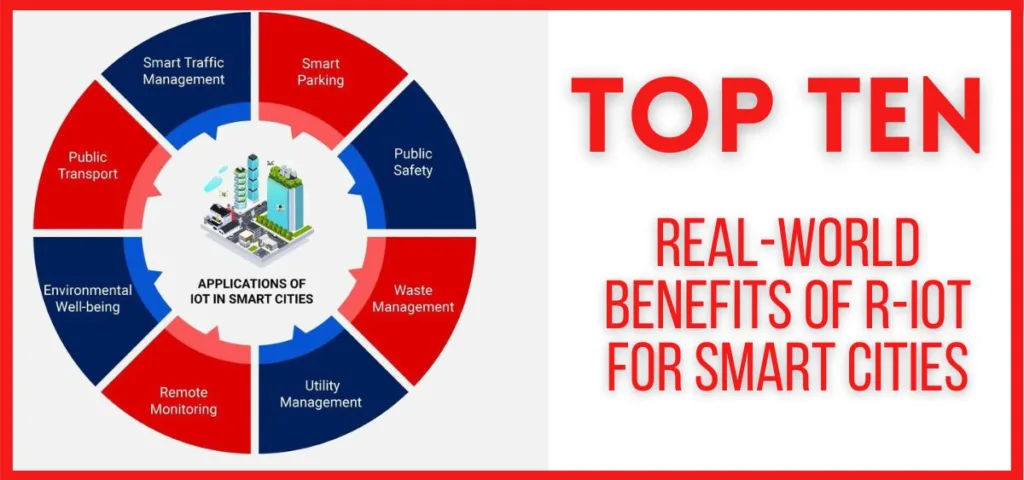One way to make cities smarter is with a special kind of technology called the “remote Internet of Things” (R-IOT). R-IOT uses tiny gadgets that can talk to each other over the internet, even if they’re far apart. These gadgets can sense things happening in the city, like how many cars are on the road or how full a trash can is. Then, they send this information to a computer that can figure out how to make things better.
Our cities are getting crowded! More and more people are moving there, and that’s going to keep happening. To make sure everyone has a nice place to live, cities need to be smarter. Imagine a city that knows when traffic jams are happening and can fix them, or one that can spot overflowing trash cans and send trucks to empty them right away. That’s a smart city! R-IOT, along with smart planning by city officials, can help our cities run smoothly. It can mean less traffic, cleaner air, and happier citizens!
IoT can be used in many ways to make cities more efficient, ranging from managing traffic, controlling air pollution, handling waste management, creating smart buildings, planning for natural disasters, etc. So let’s see how modern technologies combined with civic planning can result in smart cities that are more efficient and cost-effective.
Also, read: Top Ten Reasons To Join Stevens Applied Artificial Intelligence Course
Beyond the Hype: Top 10 Real-World Benefits of R-IOT for Smart Cities
R-IOT, which stands for Remote Internet of Things, takes the traditional Internet of Things (IoT) a step further by enabling communication and data collection from sensors and devices in remote locations. This technology is proving to be a game-changer for smart cities, offering a wide range of benefits that can improve the lives of citizens and make cities more efficient and sustainable. Here are the top 10 real-world benefits of R-IOT for smart cities:

1. Improved Traffic Management
Are you ever stuck in traffic, wishing you knew a better way to get around? Remote Internet of Things (R-IoT) can help! Imagine tiny sensors embedded in roads and traffic lights, constantly feeding real-time data on traffic flow, accidents, and even parking availability. This information is then analyzed by computers that can adjust traffic light timing to ease congestion, and drivers can receive updates on their phones suggesting alternate routes to avoid jams.
R-IoT doesn’t stop there; it can also connect to public transportation systems, allowing apps to display real-time bus and train locations, so you can ditch the car altogether! The result? Less time wasted in traffic, cleaner air from reduced emissions, and a more relaxed and efficient journey for everyone. The remote Internet of Things is paving the way for smoother traffic flow, making our cities smarter and our commutes less stressful.
Also, read: Top 10 AI Myths You Should Know
2. Smarter Parking
Finding parking in a crowded city can be a nightmare. You waste time circling blocks, fumes fill the air, and frustration builds. But what if you could see available parking spaces on your phone before you even left home? This is the reality of smart parking powered by the Internet of Things (R-IOT). R-IOT uses sensors in parking spaces to detect if a car is parked or not. This information is then sent to a central system and shared with drivers through apps.
This not only saves you time and reduces the hassle of searching for parking, but it also helps reduce traffic congestion caused by circling cars. Additionally, R-IOT can streamline parking payments by allowing you to pay directly through the app, eliminating the need for meters or kiosks. Smart parking with remote Internet of Things is a win-win for drivers, cities, and the environment by making parking easier, traffic smoother, and our cities a little bit greener.
3. Enhanced Public Safety
Imagine a city where crime is deterred before it even happens, or where emergencies are responded to faster than ever before. This vision of a safer city is becoming a reality thanks to remote Internet of Things (R-IOT) technology. The remote Internet of Things uses a network of sensors and cameras spread throughout the city that can detect suspicious activity, fires, and even accidents in remote locations. This real-time data allows authorities to deploy resources more efficiently, directing police officers to potential crime scenes or sending firefighters directly to where a blaze has ignited.
R-IOT can also be used to create virtual patrol zones, where strategically placed sensors monitor public spaces and alert authorities if unusual activity is detected. Furthermore, R-IOT data can be used to predict crime hotspots, allowing for preventative measures to be taken in high-risk areas. This combination of real-time data and proactive planning empowers law enforcement to safeguard our communities and create a safer environment for everyone.
Also, read: Top Ten Deep Learning Techniques for Cutting-Edge AI Applications
4. Efficient Waste Management
Imagine overflowing trash cans and overflowing streets! Not exactly the picture of a pleasant city. Thankfully, R-IOT (remote Internet of Things) can help tackle this growing problem. Tiny sensors placed on bins can tell exactly how full they are, sending this information straight to waste collection companies. This means no more overflowing bins or unnecessary truck trips, reducing fuel use and pollution.
R-IOT can even analyze waste patterns, predicting when bins will be full and optimizing collection routes for maximum efficiency. This not only saves money but also keeps our cities cleaner and healthier!
5. Sustainable Resource Management
Our cities are resource guzzlers! Energy, water, and waste pile up as our urban populations grow. But what if we could manage these resources more wisely? Enter the Remote Internet of Things (R-IOT)! This amazing technology uses hidden sensors that talk to each other over the internet, even across long distances. Imagine tiny detectives monitoring everything from water leaks to overflowing trash cans. R-IOT sends this real-time information to a computer brain that can identify problems and optimize solutions. For water, this could mean fixing leaks before they waste gallons.
For waste, R-IOT helps plan collection routes, saving fuel and reducing overflowing bins. Even energy use gets a boost! R-IOT can track electricity use in buildings, helping us identify areas to conserve power. By making smarter decisions about our resources, R-IOT paves the way for cleaner air, less pollution, and a more sustainable future for our cities. So buckle up, because R-IOT is taking our cities on a journey toward a greener tomorrow!
Also, read: Exploring the Top Ten Deep Learning Frameworks: A Comprehensive Guide
6. Improved Infrastructure Management
Our cities rely on a complex network of roads, bridges, buildings, and pipes to function smoothly. But keeping these infrastructures in good shape can be a challenge. R-IOT (Remote Internet of Things) offers a game-changer for managing our city’s infrastructure. Imagine tiny sensors embedded in bridges that can detect cracks before they become major problems, or sensors in water pipes that can pinpoint leaks before they cause costly damage. R-IOT makes this a reality. This network of sensors constantly collects data, giving city officials a real-time picture of infrastructure health.
This allows for early intervention, preventing costly repairs and disruptions, and extending the lifespan of our vital infrastructure. R-IOT doesn’t stop there. It can also monitor traffic flow on bridges, helping to optimize traffic light timing and reduce congestion. By harnessing the power of R-IOT, cities can ensure their infrastructure remains strong and reliable, creating a safer and more efficient environment for everyone.
7. Citizen Engagement
Imagine a city that listens! With Remote Internet of Things (R-IOT), smart cities can become more responsive to their residents’ needs. R-IOT sensors can be placed everywhere, from parking spots to noise monitors, collecting data on city issues. But R-IOT isn’t just about collecting information; it’s about empowering you, the citizen, to be part of the solution. Through user-friendly apps and online platforms, you can report problems like potholes or overflowing trash, directly impacting how your city is managed.
This two-way communication loop allows you to see how your reports translate into action, fostering a sense of community and shared responsibility. R-IOT can even be used to conduct polls and surveys, ensuring your voice is heard on important decisions about everything from park design to traffic light timing. In short, R-IOT empowers citizens to become active participants in shaping their smart city, creating a more livable and responsive urban environment for everyone.
Also, read: Top Ten Augmented Reality App Development Companies for 2023
8. Better Public Transportation
Imagine waiting for a bus on a hot afternoon, only to see it already full. Frustrating, right? R-IOT can change that! R-IOT sensors on buses can track their location in real-time, and apps can share this information with you. No more endless waiting! Remote Internet of Things can also help bus companies adjust routes based on passenger data, so buses go where they’re needed most.
This means shorter wait times and less crowded rides. The remote Internet of Things can even be used to improve traffic light timing for buses, keeping them moving and on schedule. The result? A more reliable, efficient, and frustration-free public transportation system that encourages more people to ditch their cars and use eco-friendly public transit!
9. Environmental Monitoring
Keeping our cities clean and healthy is a constant challenge. But imagine a city that can constantly monitor its own air and water quality! This is the power of R-IOT (Remote Internet of Things) for environmental monitoring. R-IOT sensors can be placed throughout the city, silently gathering data on air pollution levels, noise pollution, and even water quality in rivers and streams. This real-time data is then sent to a central hub for analysis. City officials can use this information to identify problem areas, like factories causing excessive air pollution, and take appropriate action.
Remote Internet of Things can also be used to track waste collection, ensuring overflowing bins are emptied promptly to minimize unpleasant odors and potential health hazards. By providing a constant stream of environmental data, the remote Internet of Things empowers cities to become proactive in protecting their environment and ensuring the health and well-being of their citizens.
Also, read: Unraveling the Top Ten Deep Learning Libraries for Neural Network Enthusiasts
10. Boosted Economic Development
Imagine a city that attracts businesses and investment like a magnet. R-IOT can make this a reality by fostering a thriving economic environment. Here’s how: R-IOT data can be used to identify areas with high foot traffic, perfect for new shops and restaurants. Efficient waste management with R-IOT reduces costs for businesses, making the city more attractive. Additionally, the remote Internet of Things helps create a more secure environment through real-time crime monitoring, giving businesses peace of mind.
Furthermore, R-IOT allows for better traffic management, reducing commute times, and making the city more attractive to a skilled workforce. This, in turn, attracts companies looking for a talented talent pool. Finally, the remote Internet of Things can be used to develop innovative smart city applications and services, creating new business opportunities and attracting investment in the tech sector. By making cities more efficient, livable, and secure, R-IOT paves the way for robust economic growth.
FAQs: Benefits of R-IOT for Smart Cities
Q. What’s the difference between regular IoT and R-IOT?
Regular IoT connects devices in a local network, while R-IOT (Remote-IoT) allows communication and data collection from sensors even in faraway locations. Imagine a traffic sensor in a remote suburb sending data to the city center!
Also, read: Top 10 Tips and Tricks to Master Google Cloud TensorFlow
Q. How can the remote Internet of Things improve traffic flow?
R-IOT sensors can monitor traffic in real-time, allowing cities to adjust traffic light timings and inform drivers of congestion. This can significantly reduce traffic jams and commute times.
Q. Isn’t remote Internet of Things expensive? How can cities afford it?
While there’s an initial investment, R-IOT often leads to long-term savings. For example, optimizing waste collection with R-IOT reduces the number of trucks needed, saving on fuel and manpower. Additionally, smart cities often attract investment and businesses, boosting the city’s revenue.
Q. Is R-IOT safe? What about privacy concerns?
Security is a major consideration in R-IOT. Cities need robust cybersecurity measures to protect collected data. Privacy concerns are also valid. Citizens should be informed about how their data is used and have control over it.
Also, read: Top 10 Advanced Robots in the World
Q. What are some of the biggest challenges for implementing the remote Internet of Things in cities?
Standardization is a key challenge. Different devices and communication protocols can create compatibility issues. Additionally, integrating R-IOT with existing city infrastructure requires careful planning and collaboration.
Conclusion: The Final Thought
In conclusion, the adoption of the remote Internet of Things holds immense promise for the advancement of smart cities, offering a wide array of benefits ranging from enhanced public safety and sustainability to improved service delivery and economic growth. By harnessing the power of real-time data and connectivity, cities can overcome pressing challenges, drive innovation, and create more livable and resilient urban environments for future generations.
Overall, R-IOT has the potential to transform our cities into more livable, sustainable, and efficient places. As remote Internet of Things technology continues to develop, we can expect to see even more innovative applications that improve the quality of life for citizens around the world.


































